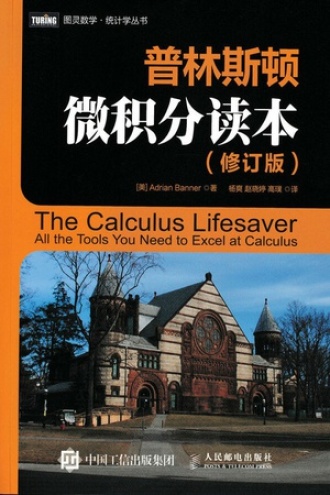作者:
David C.Lay
出版社: 高等教育出版社
原作名: Linear Algebra and Its Applications
出版年: 2016-5-1
页数: 576
定价: 69.00元
装帧: 平装
ISBN: 9787121285912
出版社: 高等教育出版社
原作名: Linear Algebra and Its Applications
出版年: 2016-5-1
页数: 576
定价: 69.00元
装帧: 平装
ISBN: 9787121285912
豆瓣评分
内容简介 · · · · · ·
线性代数是处理矩阵和向量空间的数学分支科学,在现代数学的各个领域都有应用。本书主要包括线性方程组、矩阵代数、行列式、向量空间、特征值和特征向量、正交性和最小二乘方、对称矩阵和二次型等内容。本书的目的是使学生掌握线性代数最基本的概念、理论和证明。首先以常见的方式,具体介绍了线性独立、子空间、向量空间和线性变换等概念,然后逐渐展开,最后在抽象地讨论概念时,它们就变得容易理解多了。
作者简介 · · · · · ·
David C. Lay:美国奥罗拉大学学士,加州大学洛杉矶分校硕士、博士,教育家。1976年起开始在马里兰大学从事数学教学与研究工作,阿姆斯特丹大学、自由大学、德国凯撒斯劳滕工业大学访问学者,在函数分析和线性代数领域发表文章30余篇。美国国家科学基金会资助的线性代数课程研究小组的创始人,参与编写了《函数分析、积分及其应用导论》和《线性代数精粹》等书。
目录 · · · · · ·
CHAPTER 1 Linear Equations in Linear Algebra
INTRODUCTORY EXAMPLE: Linear Models in Economics and Engineering
1.1 Systems of Linear Equations
1.2 Row Reduction and Echelon Forms
1.3 Vector Equations
1.4 The Matrix Equation Ax=b
· · · · · · (更多)
INTRODUCTORY EXAMPLE: Linear Models in Economics and Engineering
1.1 Systems of Linear Equations
1.2 Row Reduction and Echelon Forms
1.3 Vector Equations
1.4 The Matrix Equation Ax=b
· · · · · · (更多)
CHAPTER 1 Linear Equations in Linear Algebra
INTRODUCTORY EXAMPLE: Linear Models in Economics and Engineering
1.1 Systems of Linear Equations
1.2 Row Reduction and Echelon Forms
1.3 Vector Equations
1.4 The Matrix Equation Ax=b
1.5 Solution Sets of Linear Systems
1.6 Applications of Linear Systems
1.7 Linear Independence
1.8 Introduction to Linear Transformations
1.9 The Matrix of a Linear Transformation
1.10 Linear Models in Business, Science,and Engineering
Supplementary Exercises
CHAPTER 2 Matrix Alqebra
INTRODUCTORY EXAMPLE: Computer Models in Aircraft Design
2.1 Matrix Operations
2.2 The Inverse of a Matrix
2.3 Characterizations of Invertible Matrices
2.4 Partitioned Matrices
2.5 Matrix Factorizations
2.6 The Leontief Input—Output Model
2.7 Applications to Computer Graphics
2.8 Subspaces of Rn
2.9 Dimension and Rank
Supplementary Exercises
CHAPTER 3 Determinants
INTRODUCTORY EXAMPLE: Determinants in Analytic Geometry
3.1 Introduction to Determinants
3.2 Properties of Determinants
3.3 Cramer's Rule, Volume, and Linear Transformations
Supplementary Exercises
CHAPTER 4 Vector Spaces
INTRODUCTORY EXAMPLE: Space Flight and Control Systems
4.1 Vector Spaces and Subspaces
4.2 Null Spaces, Column Spaces, and Linear Transformations
4.3 Linearly Independent Sets; Bases
4.4 Coordinate Systems
4.5 The Dimension of a Veaor Space
4.6 Rank
4.7 Change of Basis
4.8 Applications to Difference Equations
4.9 Applications to Markov Chains
Supplementary Exercises
CHAPTER 5 Eiqenvalues and Eiqenvectors
INTRODUCTORY EXAMPLE: Dynamical Systems and Spotted Owls
5.1 Eigenvectors and Eigenvalues
5.2 The Characteristic Equation
5.3 Diagonalization
5.4 Eigenvectors and Linear Transformations
5.5 Complex Eigenvalues
5.6 Discrete Dynamical Systems
5.7 Applications to Differential Equations
5.8 Iterative Estimates for Eigenvalues
Supplementary Exercises
CHAPTER 6 Orthogonality and Least Squares
INTRODUCTORY EXAMPLE: Readjusting the North American Datum
6.1 Inner Product, Length, and Orthogonality
6.2 Orthogonal Sets
6.3 Orthogonal Projections
6.4 The Gram—Schmidt Process
6.5 Least—Squares Problems
6.6 Applications to Linear Models
6.7 Inner Product Spaces
6.8 Applications oflnner Product Spaces
Supplementary Exercises
CHAPTER 7 Symmetric Matrices and Quadratic Forms
INTRODUCTORY EXAMPLE: Multichannel Image Processing
7.1 Diagonalization of Symmetric Matrices
7.2 Quadratic Forms
7.3 Constrained Optimization
7.4 The Singular Value Decomposition
7.5 Applications to Image Processing and Statistics
Supplementary Exercises
Appendixes
A Uniqueness of the Reduced Echelon Form
B Complex Numbers
Glossary
Answers to Odd—Numbered Exercises
Index
· · · · · · (收起)
INTRODUCTORY EXAMPLE: Linear Models in Economics and Engineering
1.1 Systems of Linear Equations
1.2 Row Reduction and Echelon Forms
1.3 Vector Equations
1.4 The Matrix Equation Ax=b
1.5 Solution Sets of Linear Systems
1.6 Applications of Linear Systems
1.7 Linear Independence
1.8 Introduction to Linear Transformations
1.9 The Matrix of a Linear Transformation
1.10 Linear Models in Business, Science,and Engineering
Supplementary Exercises
CHAPTER 2 Matrix Alqebra
INTRODUCTORY EXAMPLE: Computer Models in Aircraft Design
2.1 Matrix Operations
2.2 The Inverse of a Matrix
2.3 Characterizations of Invertible Matrices
2.4 Partitioned Matrices
2.5 Matrix Factorizations
2.6 The Leontief Input—Output Model
2.7 Applications to Computer Graphics
2.8 Subspaces of Rn
2.9 Dimension and Rank
Supplementary Exercises
CHAPTER 3 Determinants
INTRODUCTORY EXAMPLE: Determinants in Analytic Geometry
3.1 Introduction to Determinants
3.2 Properties of Determinants
3.3 Cramer's Rule, Volume, and Linear Transformations
Supplementary Exercises
CHAPTER 4 Vector Spaces
INTRODUCTORY EXAMPLE: Space Flight and Control Systems
4.1 Vector Spaces and Subspaces
4.2 Null Spaces, Column Spaces, and Linear Transformations
4.3 Linearly Independent Sets; Bases
4.4 Coordinate Systems
4.5 The Dimension of a Veaor Space
4.6 Rank
4.7 Change of Basis
4.8 Applications to Difference Equations
4.9 Applications to Markov Chains
Supplementary Exercises
CHAPTER 5 Eiqenvalues and Eiqenvectors
INTRODUCTORY EXAMPLE: Dynamical Systems and Spotted Owls
5.1 Eigenvectors and Eigenvalues
5.2 The Characteristic Equation
5.3 Diagonalization
5.4 Eigenvectors and Linear Transformations
5.5 Complex Eigenvalues
5.6 Discrete Dynamical Systems
5.7 Applications to Differential Equations
5.8 Iterative Estimates for Eigenvalues
Supplementary Exercises
CHAPTER 6 Orthogonality and Least Squares
INTRODUCTORY EXAMPLE: Readjusting the North American Datum
6.1 Inner Product, Length, and Orthogonality
6.2 Orthogonal Sets
6.3 Orthogonal Projections
6.4 The Gram—Schmidt Process
6.5 Least—Squares Problems
6.6 Applications to Linear Models
6.7 Inner Product Spaces
6.8 Applications oflnner Product Spaces
Supplementary Exercises
CHAPTER 7 Symmetric Matrices and Quadratic Forms
INTRODUCTORY EXAMPLE: Multichannel Image Processing
7.1 Diagonalization of Symmetric Matrices
7.2 Quadratic Forms
7.3 Constrained Optimization
7.4 The Singular Value Decomposition
7.5 Applications to Image Processing and Statistics
Supplementary Exercises
Appendixes
A Uniqueness of the Reduced Echelon Form
B Complex Numbers
Glossary
Answers to Odd—Numbered Exercises
Index
· · · · · · (收起)
喜欢读"线性代数及其应用 (第3版·英文版)"的人也喜欢的电子书 · · · · · ·
支持 Web、iPhone、iPad、Android 阅读器
喜欢读"线性代数及其应用 (第3版·英文版)"的人也喜欢 · · · · · ·
线性代数及其应用 (第3版·英文版)的书评 · · · · · · ( 全部 49 条 )
挺好的 看完后对LA建立起了基本概念
因为是考研学习LA 所以看了全国被普遍采用的那本紫色的同济LA教材,看着看着我发现那本书其实只是一本 线性代数公式大全,言简意赅到一个境界了,不适合我这样的普通智商的学生参读。 后来选择了这本LA&applications 觉得很不错。每章用一个introductory example开头 让...
(展开)
配合B站视频 使用效果更佳
这本书对于概念介绍得非常清晰,比我本科学的线代教材好太多了。本科的小朋友如果看不懂自己学校出的线代教材,强烈推荐看这本书+B站3Blue1Brown的视频~通过看视频,可以从空间角度(从本质上)理解线代中各个概念的本质 B站有一个叫“ 婆婆町 ”的博主,做了 “线性代数的本...
(展开)
> 更多书评 49篇
论坛 · · · · · ·
在这本书的论坛里发言这本书的其他版本 · · · · · · ( 全部25 )
-
机械工业出版社 (2005)9.1分 1096人读过
-
Pearson (2011)9.1分 90人读过
-
机械工业出版社 (2018)9.7分 508人读过
-
人民邮电出版社 (2007)9.2分 115人读过
以下书单推荐 · · · · · · ( 全部 )
- 那些我看过的线性代数教材 (ChEFT)
- 计算机科学与技术 (子苓)
- math (水坎火离)
- 数学 (Hermann)
谁读这本书? · · · · · ·
二手市场
· · · · · ·
- 在豆瓣转让 有16人想读,手里有一本闲着?
订阅关于线性代数及其应用 (第3版·英文版)的评论:
feed: rss 2.0













1 有用 7086 2020-08-18 11:17:34
最后一个章节从线性代数的观点导出了对傅立叶系数的计算方法,而且十分简单,实在是精彩。读过之后你可能还不懂傅立叶分析的细节,但是你会知道它如何逼近周期函数,并且可以自己动手写出一系列的傅立叶级数。
2 有用 ChEFT 2020-08-02 10:25:43
非常均衡的一本教材,计算、证明与应用三大部分的内容讲解都很细致。考虑到线性代数具有一定的抽象性,作者还使用了一些几何方法帮助读者们去理解线性代数中的各种概念,对初学者牢固地掌握各种概念有很大的帮助。此外作者在教学中还比较重视计算机的使用,每一节后的习题都包含若干道上机题目,这一点值得国内的教材学习。整体来说本书是一本极好的线性代数入门书,非常适合初学者使用。不过相比国内的教材,本书的内容要多出不少... 非常均衡的一本教材,计算、证明与应用三大部分的内容讲解都很细致。考虑到线性代数具有一定的抽象性,作者还使用了一些几何方法帮助读者们去理解线性代数中的各种概念,对初学者牢固地掌握各种概念有很大的帮助。此外作者在教学中还比较重视计算机的使用,每一节后的习题都包含若干道上机题目,这一点值得国内的教材学习。整体来说本书是一本极好的线性代数入门书,非常适合初学者使用。不过相比国内的教材,本书的内容要多出不少,一个学期应该讲不完(美国的线性代数课程有时会长达一年)。以矩阵的分解为例,本书中不仅介绍了谱分解,还介绍了QR分解和SVD分解,而后两者在国内一般是矩阵论中的内容。如果只是为了应付考试而自学的话,书中的很多部分是可以跳过的。 (展开)